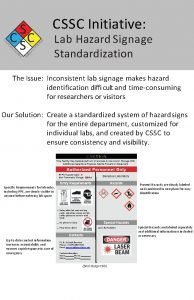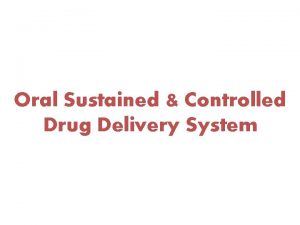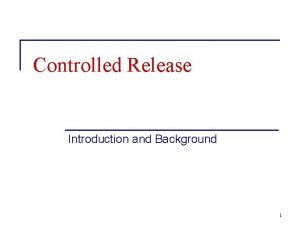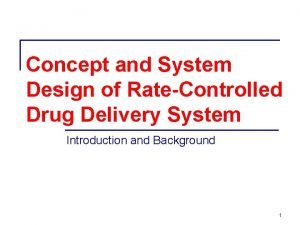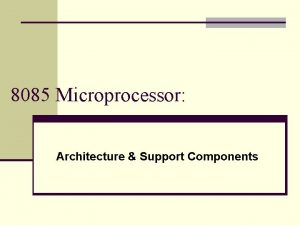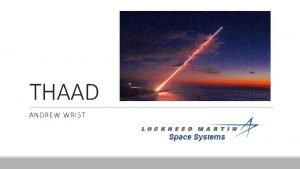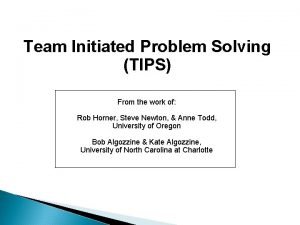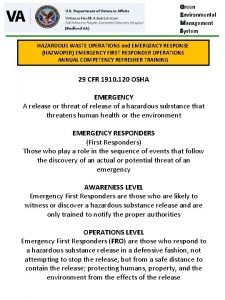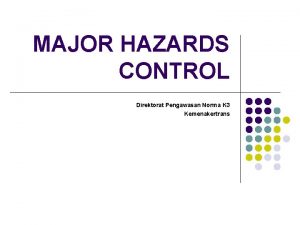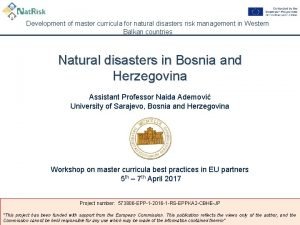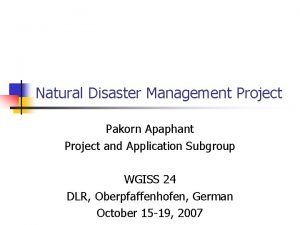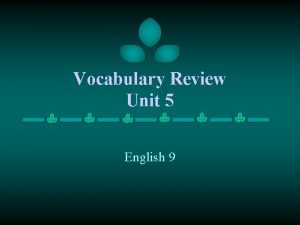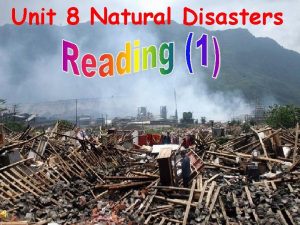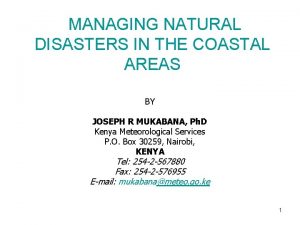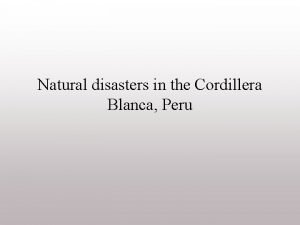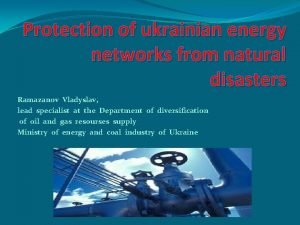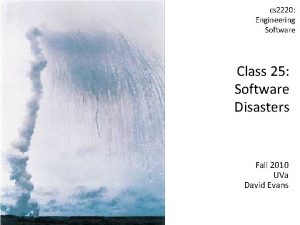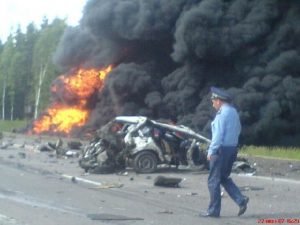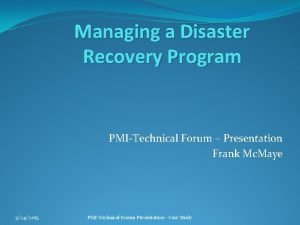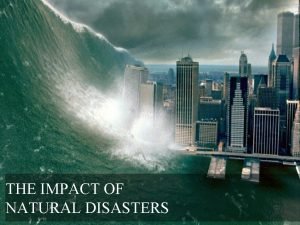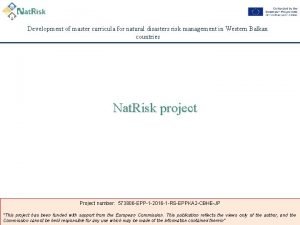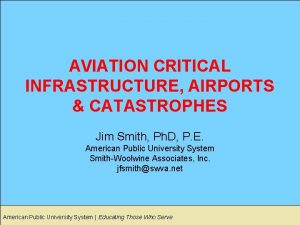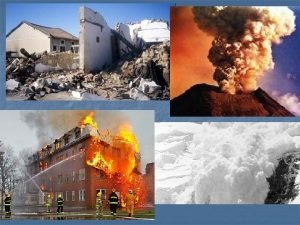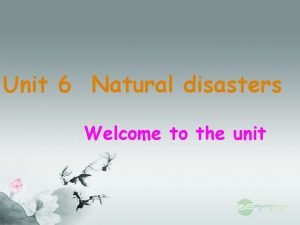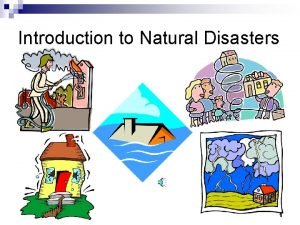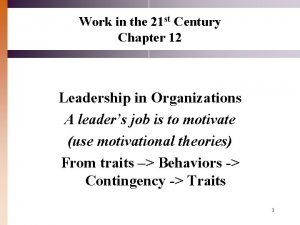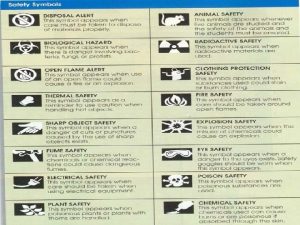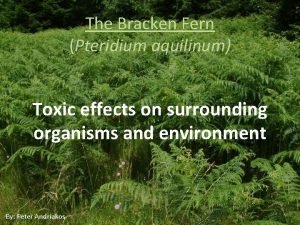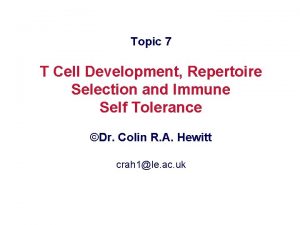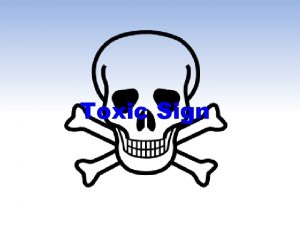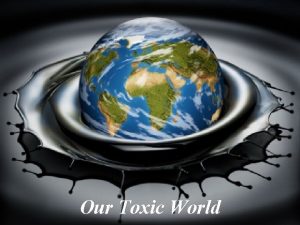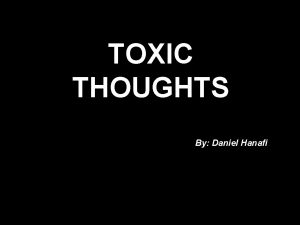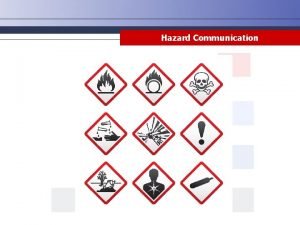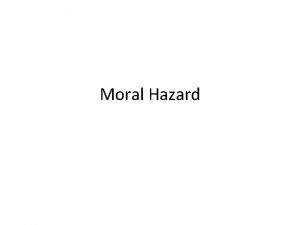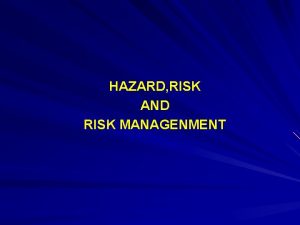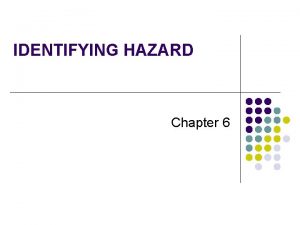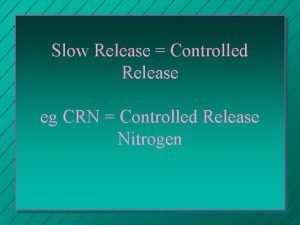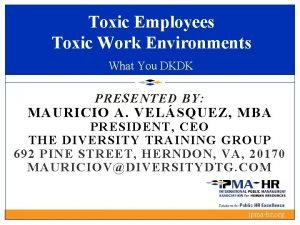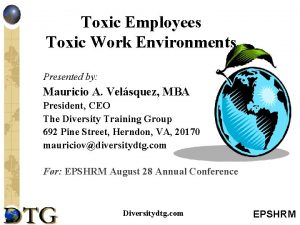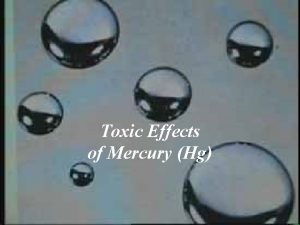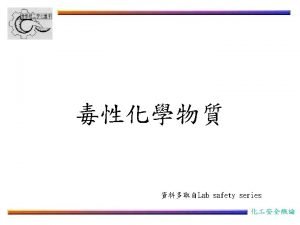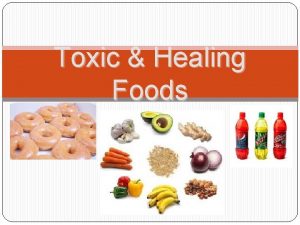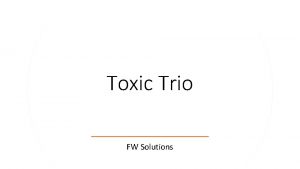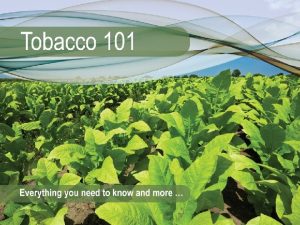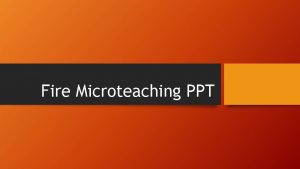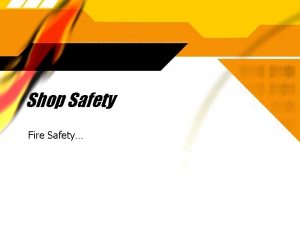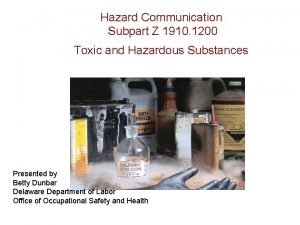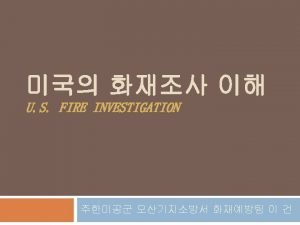Major Disasters Fire Initiated Toxic Release HAZARD ANYTHING



















































- Slides: 51

Major Disasters Fire Initiated Toxic Release

HAZARD ANYTHING WITH POTENTIAL FOR PRODUCING AN ACCIDENT. RISK PROBABILITY OF HAZARD RESULTING AN ACCIDENT.

Strategic Management Operations Management Risk Management

MAJOR FIRE RISK IDENTIFICATION RISK ANALYSIS NO TRANSACTIONAL DECISION YES Risk Control No Risk Management Transfer Reduce Retain

For any Industrial Process Plant Following questions must be asked answered 1. What are the Hazards ? 2. What can go wrong and how? 3. What are the chances? 4. What are the consequences?

CONESQUENCES OF HAZARDOUS EVENT • FIRE/ EXPLOSION • VAPOUR CLOUD EXPLOSION • FORMATION OF TOXIC ATMOSPHERE

Different Terminologies of Hazardous Situations • Pool Fire • Jet Fire • Flash/ Cloud Fire • Vapour Cloud Explosion (VCE) • High Pressure Rupture • BLEVE • Release of Toxic Gases/ Liquids

Heat Radiation levels and Damage Effects (As per API 521) Radiation Level (k. W/Sq. m) 4. 0 12. 5 37. 5 Observed Effect Sufficient to cause pain to personnel within 20 second Minimum Energy required for piloted ignition of Wood and melting of Plastic Tubing Sufficient to cause damage to Process Equipment

Explosion Over Pressure Level and Damage Effects Overpressure (bar) Damage produced by Blast Effect 0. 02 0. 13 0. 20 No considerable damage except shattering of few glass panes Partial collapse of Buildings Steel framed building distorted and pulled away from the foundation

THE FIRST STAGE OF RISK ASSESSMENT IN A PROCESS PLANT ESSENTIALLY CONSISTS OF THREE STEPS: 1. IDENTIFYING THE HAZARD 2. ESTIMATING THE EFFECTS OR CONSEQUENCES OF THE HAZARD 3. DETERMINING PROBABILITY OR LIKELIHOOD OF OCCURRENCE OF HAZARDOUS EVENT

THE NEXT STEP OF RISK ASSESSMENT TO DETERMINE WHETHER EFFECTS OF THE CONSEQUENCE AND THE PROBABAILITY OF OCCURRENCE OF THE HAZARD IS WITHIN THE ACCEPTABLE LIMIT OR NOT.

HAZARD IDENTIFICATION METHODOLOGY HAZARDS IN PROCESS PLANTS ARE PRIMARILY IDENTIFIED BASED ON FOLLOWING INFORMATION: • HAZARDOUS PROPERTIES OF MATERIALS • TYPE OF UNIT PROCESS/ OPERATION • OPERATING PARAMETERS • ANY OTHER RELEVENT DATA NFPA CODE NO. 325 M CHECK-LIST DOW INDEX

COMMONLY USED STRUCTURED HAZARD IDENTIFICATION TECHNIQUES 1. WHAT IF ? ANALYSIS: • What if the Raw Material contains impurities? • What if Cooling Water is Lost? • What if the Vessel Agitation Stops? • What if Power Supply Fails? • What if the Temp. / Press. Sensor Fail? • What if the Pump Stops? etc.

2. HAZOP STUDY GUIDE WORDS • NO • MORE • LESS • AS WELL AS • PART OF • REVERSE • OTHER THAN, etc.

3. FAILURE MODE AND EFFECTS ANALYSIS (FMEA) FMEA evaluates the ways in which an Equipment can Fail and the Effects of such Failures on an Installation 4. FAULT TREE ANALYSIS (FTA) Deductive Reasoning Process 5. EVENT TREE ANALYSIS (ETA) Inductive Process

RISK ACCEPTABILITY CRITERIA Statistical Experience Shows • Chance of Death due to Risk of Driving, Flying or Smoking is 1 in 100000 or 10 – 5 • Chance of Death from Lightning or Falling of Aircraft is around 10 – 7 or 1 in 10000000 It is therefore generally accepted that the Risk of Death 1 in 100000 or 10 – 5 per Year is Alarming. Action needs to be taken to Reduce the Risk BELOW the level 1 in 1000000 or 10 – 6 per Year and it is generally accepted without concern for Industrial People.

PROBABILITY ESTIMATION Failure Rate data for Some Equipment Process Pressure Vessel Pressure Storage Vessel Heat Exchangers Fired Heaters High Temperature vessel, except Fired Heater Low Temperature Vessel Failure Rate (Failures/ Year) 2. 7 x 10 -3 1. 8 x 10 -3 1. 7 x 10 -3 405 x 10 – 3 7. 4 x 10 -3 1. 5 x 10 -3

CONSEQUENCE ESTIMATION Software Package Organisation EFFECTS TNO, Netherlands CISCOM CISRA, CLRI, CHENNAI CHARM Radian Corporation POOL FIRE/ BLEVE/ EXPLOSION Package IIT, Kanpur EAHAP Energy Analyst Corporation HASTE ERT Inc SLAB TRACE PHAST Ex- TOOL Lawrence Livermore National Lab Safer Corporation DNV Technica Swiss Re

Public or Societal Risk E x p e ct e d F re q u e n c y 103 FN Curve for Societal Risk F Unacceptable 105 F. N. Lines Reduction Desired Acceptable 102 Nos. of Probable Fatalities N 103

RISK CONTROL MEASURES • Physical Protection • Procedural Protection • Educational Protection

Physical Protection • Strict & Rigorous approach in following the Relevant Standards , Codes & Practices • Built in Safety Devices and Safety System • Venting through Tall stacks • Field Monitors for Different Toxic Gases • Burning Waste gases in a Flare System • Provision of Wind Cones • Fire Proofing of Steel Structures • PPE • Passive Protection System • Active Protection system • Automatic Protection system • Improved Waste Water Management

PROCEDURAL PROTECTION • Fire Emergency Procedure • Disaster Preparedness Plan • Mutual Aid Scheme • No Smoking Policy • Investigation of All Accidents • Hazard Identification through Safety Committee, House Keeping Committee, Safety audit Committee • Conducting Plant Survey, safety survey • Work Permit System • Statutory Requirement • Safety Promotional Activities

Contd. • Information notes on Unsafe conditions • MSDS • Annual Medical Check up of Employees • Safe Start up & Shut Down Procedure • Regular and Preventive Maintenance • Periodic testing of Fire Fighting Appliances

EDUCATIONAL PROTECTION • Periodic Training Programme on Safety, Fire Safety and Hazardous properties of materials • Mock Fire Drill • Safety Manuals • Health & Safety News Bulletins • Safety Motivation schemes • Plant Operating Manual

GROWING IMPORTANCE OF RISK MANAGEMENT DUE TO • LEGISLATION • CUSTOMER ATTITUDE • SOCIETAL EXPECTATIONS • MANAGEMENT ATTITUDES

The Science of Fire vkx dk fo. Kku

fpax kjh rki@ EXTINGUISHING MECHANISM * STARVATION * SMOTHERING * COOLING He tu Dlh @vk gok at Air FIRE TRIANGLE vf. Xu f=Hkqt Fuel Toyu’khy ink. Fk. Z vkx cq>kus ds rjhds * Hkw[kk ekjuk * xyk ? kks. Vuk * Ba. Mk djuk • It takes three things to cause a • If we take any one of these things fire away, the fire cannot survive ; fn ge fdlh , d Hkqtk dks g. Vk nsxsa rks vkx cq> – Heat - something that is hot tk, xh. A – Fuel - something that will burn – Oxygen - the air all around us

Remember when we talked about the Fire Triangle?

• If you remove any one element, you prevent the chemical chain reaction that results from fire • ; fn ge fdlh , d Hkqtk dks g. Vk nsxsa rks psu fj, D’ku can gks tk, xk r. Fkk vkx cq> tk, xh. A • Removing Heat (Cooling/ Ba. Mk djuk) – Control of • • smoking materials matches and lighters heating appliances candles Oxygen or the air all around us gok@vk. Dlhtu – Suppression • water cools a fire Fuel - or something that will burn / Toyu’khy ink. Fk. Z

Fire Triangle • Removing Oxygen (Smothering/ xyk ? kks. Vuk) – Stop, drop and roll – Smothering action – Blanketing effect And when we remove any one side of the triangle, like taking away the oxygen, the fire cannot survive

He at Oxygen/Air • Removing Fuel (Starvation / Hkw[kk ekjuk) – Education messages • good housekeeping practices • storage of flammable liquids – in approved containers – away from heat sources

FIRE TETRAHEDRON FIRE EXTINGUISHING MECHANISM Ø STARVATION / Hkw[kk ekjuk Ø SMOTHERING / xyk ? kks. Vuk Ø COOLING / Ba. Mk djuk Ø CHAIN REACTION INHIBITION / psu fj, D’ku jksduk

FIRE EXTINGUISHING MEDIA • • • WATER ikuh CARBON DIOXIDE dkc. Zu Mkb vk. Dlkb. M % lh- vks- Vw DRY CHEMICAL POWDER Mzkb. Z dsfedy iko. Mj SAND jsr FIRE FIGHTING FOAM Qkse vkx cq>kus dk HALON ALTERNATIVES g. Syksu ds le: i

A Fire Classes C Trash Wood Paper B Liquids Grease • • • Wood /yd. Mh Cloth / di. Mk Paper / dkxt • • rubber many plastics • Gasoline / • Oil / rsy • • is. Vzksy grease tar oil-based paint lacquer Electrical Equipment / Flammable gas • energized electrical equipment fctyh ds midj. k • COMBUSTIBLE D METALS • • • flammable gases x. Slsa magnesium sodium potassium titanium zirconium other combustible metals /kkrq

Fire Classes (cont. ) CLASS K FIRES K Cooking Media • Recently recognized by NFPA 10. • Fires involving combustible vegetable or animal nonsaturated cooking fats in commercial cooking equipment. [kkus ds rsy esa vkx dks , d vyx Js. kh nh xb. Z g. S ] ds Dykl Qk; j. A

CLASSES OF FIRE 1. CLASS “A” FIRE: - CARBONIOUS FIRE Toyu’khy Bksl o. Lrq EX. - WOOD, PAPER, COAL, PLASTIC, CLOTH, ETC EXTINGUISHING MEDIA: - WATER cq>k, a & ikuh ls 2. CLASS “B” FIRE: - FLAMMABLE LIQUID FIRE Toyu’khy nzo o. Lrq EX. – PETROLEUM PRODUCTS, GREASE, SOLVENT, PAINT, ETC EXTINGUISHING MEDIA: - FOAM, DCP cq>k, a & Qkse@Mzkb. Z dsfedy iko. Mj ls 3. CLASS “C” FIRE: - INFLAMMABLE GAS FIRE / ELECTRICAL FIRE Toyu’khy x. Sls , oa fctyh dh vkx. A EX. – LPG, METHANE, PROPANE, ACETYLENE, ETC EXTINGUISHING MEDIA: - DCP / CO 2 cq>k, a & Mzkb. Z dsfedy iko. Mj @lh-vks-Vw ls 4. CLASS “D” FIRE: - METAL FIRE /kkrq dh vkx EX. – MAGNESIUM, ALLUMINIUM, ZINC, ETC EXTINGUISHING MEDIA: - SPECIAL DRY POWDER (TEC) cq>k, a & Lis’ky Mzkb. Z dsfedy iko. Mj ls

FIRE FIGHTING SYSTEM 1. FIXED FIRE FIGHTING SYSTEM • • • 2. FIRE HYDRANT SYSTEM FLOODING SYSTEM MULSIFIRE SYSTEM WATER SPRINKLER/ SPRAY SYSTEM PORTABLE FIRE EXTINGUISHERS, ETC MOBILE FIRE FIGHTING SYSTEM • • 3. FIRE TENDER TRAILER PUMP, ETC FIX-CUM- MOBILE FIRE FIGHTING SYSTEM • • FOAM CHAMBER SYSTEM FOAM POURER SYSTEM, ETC

PORTABLE FIRE EXTINGUISHERS fof. Hk. Uu izdkj ds Nks. Vs vf. Xu’kked midj. k 1. WATER TYPE FIRE EXTINGUISHERS ikuh okyk vf. Xu’kked • • 2. CO 2 CARTRIDGE TYPE STORED PRESSURE FOAM TYPE FIRE EXTINGUISHERS Qkse okyk vf. Xu’kked • 3. MECHANICAL FOAM TYPE DRY CHEMICAL POWDER TYPE Mzkb. Z dsfedy iko. Mj okyk vf. Xu’kked • • 4. CO 2 CARTRIDGE TYPE STORED PRESSURE TYPE CARBON DIOXIDE TYPE FIRE EXTINGUISHERS lh-vks- Vw vf. Xu’kked • STORED PRESSURE TYPE

WATER TYPE FIRE EXTINGUISHER ikuh okyk vf. Xu’kked (STORED PRESSURE TYPE) SQUEEZE GRIP SAFETY CLIP/PIN PRESSURE GAUGE SIPHON TUBE PURE WATER DISCHARGE HOSE NOZZLE

MECHANICAL FOAM FIRE EXTINGUISHER Qkse okyk vf. Xu’kked PLUNGER HANDLE CO 2 CARTRIDGE FOAM MAKING BRANCH

MECHANICAL FOAM FIRE EXTINGUISHER Qkse okyk vf. Xu’kked (STORED PRESSURE TYPE) SQUEEZE GRIP SAFETY CLIP/PIN PRESSURE GAUGE SIPHON TUBE DISCHARGE HOSE AFFF SOLUTION FOAM MAKING BRANCH

DCP FIRE EXTINGUISHER Mzkb. Z dsfedy iko. Mj okyk vf. Xu’kked (CO 2 GAS CARTRIDGE TYPE) PLUNGER SAFETY PIN/CLIP CO 2 CARTRIDGE PIERCER CO 2 CARTRIDGE INNER CONTAINER DISCHARGE HOSE SIPHON TUBE DCP NOZZLE

CARBON-DI-OXIDE FIRE EXTINGUISHER lh-vks- Vw vf. Xu’kked SAFETY PIN WHEEL VALVE HIGH PRESSURE DISCHARGE HOSE CYLINDER HANDLE DISCHARGE HORN SIPHON TUBE LIQUEFIED CO 2

Fire Emergency Response R Rescue A Alarm C Contain E Extinguish

Fighting the Fire P Pull the pin A Aim low at the base of flames S Squeeze the handle S Sweep side to side


Flash point • The flash point of a liquid fuel is the temperature at which vapour given off by fuel will ignite momentarily when an external flame is applied • At flash point the liquid fuel vapour will not continue to burn • Determines the risk in storing a given liquid fuel at given temperature

Fire point • The fire point of a liquid fuel is the temperature at which vapour given off by fuel will ignite and continue to burn when an external flame is applied • In most of liquid fuels, fire point is not as clearly demarcated as flash point

Ignition point • The ignition temperature is the lowest temperature at which the liquid fuel will spontaneously combust in a normal atmosphere, such as a flame or spark. • This temperature is required to supply the activation energy needed for combustion.

Flammability limit • The minimum concentration of vapor of liquid fuel in air below which propagation of flame does not occur on contact with a source of ignition. This is known as lower flammability limit ( LFL). • There is also upper flammability limit (UFL) • Flammability is generally expressed as percentage of vapour volume in air

Flammability limit cont. • If the vapour –air mixture temperature is higher, the LFL is reduced. increasing the temperature by 100 C decreases the LFL value about 8%. • Lower flammability for HSD is approximately 9 %
 Toxic hazard symbol
Toxic hazard symbol What is controlled release
What is controlled release Nocoderm
Nocoderm Extended release vs sustained release
Extended release vs sustained release Strategic payment services
Strategic payment services Components of 8085 microprocessor
Components of 8085 microprocessor Thaad energy management steering maneuver
Thaad energy management steering maneuver Care provider background screening clearinghouse
Care provider background screening clearinghouse Team initiated problem solving
Team initiated problem solving What initiated the wife's exile in the wife's lament
What initiated the wife's exile in the wife's lament Self-initiated other-repair
Self-initiated other-repair In customer initiated interactive communication
In customer initiated interactive communication Fire hazard category
Fire hazard category Major hazard
Major hazard Damper interface panel
Damper interface panel Reichstag fire who was the fire starter
Reichstag fire who was the fire starter Fire hose reel signage standards
Fire hose reel signage standards Ire fire fire rwi
Ire fire fire rwi Race fire
Race fire Natural disasters
Natural disasters What are disasters
What are disasters Most historians agree that military disasters
Most historians agree that military disasters Taiwan earthquake
Taiwan earthquake What is the difference between mitigation and preparedness
What is the difference between mitigation and preparedness Conclusion of natural disasters
Conclusion of natural disasters Emergency care first aid and disasters
Emergency care first aid and disasters Unit 9 natural disasters
Unit 9 natural disasters Introduction of natural disaster
Introduction of natural disaster Natural disasters in the cordillera region
Natural disasters in the cordillera region Ancient natural disasters
Ancient natural disasters Listening about natural disasters
Listening about natural disasters Man-made disasters introduction
Man-made disasters introduction Natural disasters conclusion for project
Natural disasters conclusion for project Software engineering disasters
Software engineering disasters Crash that is speeding
Crash that is speeding Types of disasters
Types of disasters Natural hazards vs natural disasters
Natural hazards vs natural disasters Effects of environmental disasters
Effects of environmental disasters Natural disasters
Natural disasters Ancient natural disasters
Ancient natural disasters Explain natural disaster
Explain natural disaster Aviation critical infrastructure
Aviation critical infrastructure Accidents & disasters
Accidents & disasters Three natural disasters
Three natural disasters Conclusion on disaster management
Conclusion on disaster management English language paper 2 rail disasters mark scheme
English language paper 2 rail disasters mark scheme Multinodular goiter pathophysiology
Multinodular goiter pathophysiology Toxic triangle of destructive leadership
Toxic triangle of destructive leadership Toxic substances control
Toxic substances control Toxic
Toxic How toxic is bracken fern
How toxic is bracken fern Toxic shock syndrome
Toxic shock syndrome
